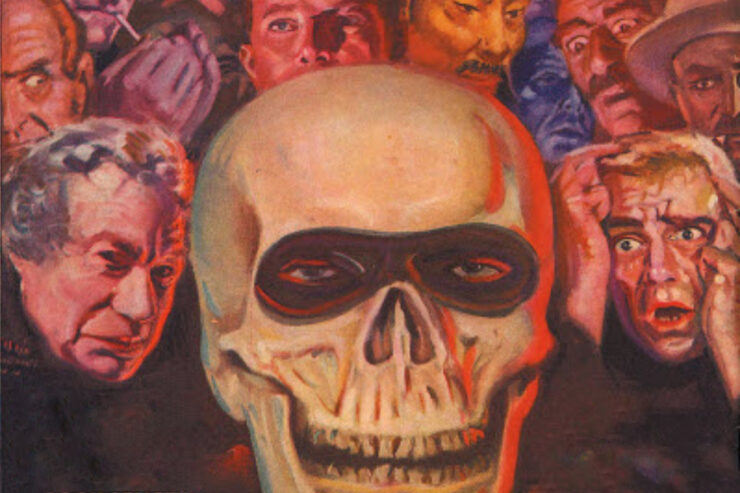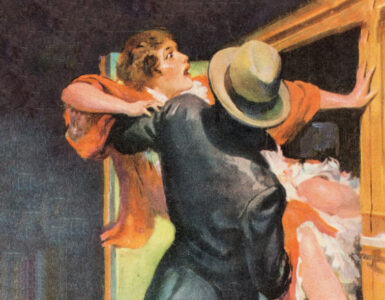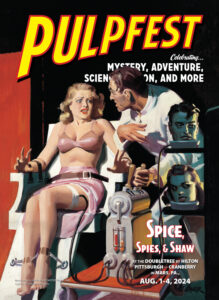 With this year’s PulpFest over, what’s up for 2024?
With this year’s PulpFest over, what’s up for 2024?
Ninety years ago, with the Great Depression in full tilt, things were tough for America and the pulp magazine industry.
Clayton — the publisher of Ace-High, Astounding Stories, Clues, Ranch Romances, Strange Tales, and other memorable pulps had gone belly up in 1932. Fiction House was slowly emerging from its publishing suspension, following the death of its co-founder Jack Kelly. Other publishers were on shaky ground.
With sales down, publishers were looking for the next new thing. Standard and Popular introduced their “dime” magazines. Nearly everyone launched single-character or “hero” pulps, modeled after Street & Smith’s top-selling The Shadow Magazine. And let’s not forget the start of the weird menace genre, launched when Harry Steeger published Norvell Page’s “Dance of the Skeletons” in the rechristened Dime Mystery Magazine in late 1933.
Around the same time that Steeger was remodeling the moribund Dime Mystery Book Magazine, a forty-year-old Jewish immigrant from Romania, Harry Donenfeld, formed “Super Magazines” with Frank Armer. A publisher of “girlie pulps” such as Gay Parisienne, La Paree, Pep Stories, and Spicy Stories, it was Donenfeld’s intent to combine eroticism “with the conventional themes of Adventure, Detective, Western and Mystery.” In 1934, Super Magazines introduced Spicy Detective Stories, followed a few months later by ashcan editions of Spicy-Adventure Stories and Spicy Mystery Stories. Donenfeld and Armer would wait until 1936 to launch Spicy Western Stories.
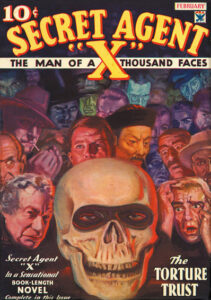 While Armer and Donenfeld tended toward “Spice,” other publishers such as Popular’s Harry Steeger and Magazine Publishers’ A. A. Wyn turned to “Spies.” With Standard Magazines, Street & Smith, and Popular Publications striking gold with their new hero pulps, Wyn jumped on the bandwagon with Secret Agent X. Launched in early 1934, Secret Agent X was a master of disguise. Known as “the man of a thousand faces,” he worked undercover fighting crime and the enemies of the United States. No one knew his real name. Created by Paul Chadwick, Secret Agent X had a fairly long run, lasting into 1939 and 41 issues.
While Armer and Donenfeld tended toward “Spice,” other publishers such as Popular’s Harry Steeger and Magazine Publishers’ A. A. Wyn turned to “Spies.” With Standard Magazines, Street & Smith, and Popular Publications striking gold with their new hero pulps, Wyn jumped on the bandwagon with Secret Agent X. Launched in early 1934, Secret Agent X was a master of disguise. Known as “the man of a thousand faces,” he worked undercover fighting crime and the enemies of the United States. No one knew his real name. Created by Paul Chadwick, Secret Agent X had a fairly long run, lasting into 1939 and 41 issues.
Just two months after Periodical House introduced their super-spy, Harry Steeger added Secret Service Operator #5 to Popular’s growing line-up of hero pulps. Debuting with its April 1934 number, the series was created by the talented Frederick C. Davis. The prolific author contributed to a wide range of genres, including aviation, detective, war, weird menace, and western fiction. In his later years, Davis even wrote for Cosmopolitan.
 Already an old hand at the hero pulp story — having created “The Moon Man” for A. A. Wyn’s Ten Detective Aces — Davis would write twenty lead stories for the Popular Publications hero pulp. Month after month, Jimmy Christopher, Secret Secret Operator #5, faced down America’s enemies in such adventures as “Cavern of the Damned,” “Blood Reign of the Dictator,” and “Invasion of the Crimson Death Cult.” Not long after the series was taken over by Emile C. Tepperman in late 1935, Christopher took on the Purple Empire in a twelve-part “future-war” series that has become known as “The War and Peace of the Pulps.” The magazine lasted until late 1939, running for 48 issues.
Already an old hand at the hero pulp story — having created “The Moon Man” for A. A. Wyn’s Ten Detective Aces — Davis would write twenty lead stories for the Popular Publications hero pulp. Month after month, Jimmy Christopher, Secret Secret Operator #5, faced down America’s enemies in such adventures as “Cavern of the Damned,” “Blood Reign of the Dictator,” and “Invasion of the Crimson Death Cult.” Not long after the series was taken over by Emile C. Tepperman in late 1935, Christopher took on the Purple Empire in a twelve-part “future-war” series that has become known as “The War and Peace of the Pulps.” The magazine lasted until late 1939, running for 48 issues.
Now that’s all well and good, but where does “Shaw” come in? Maybe 1934 saw the introduction of the “Spicy” pulps and some espionage heroes, but Joe Shaw had been the editor of Black Mask since 1926. He’d keep the job until late 1936 when he was given the heave-ho following a salary dispute.
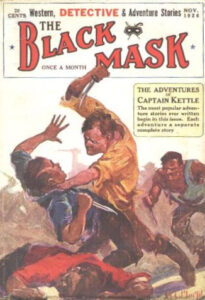 Debuting in 1920 as a general fiction pulp, The Black Mask became the home for hardboiled detective fiction. Although George Sutton and, later, Phil Cody were the editors when Carroll John Daly and Dashiell Hammett introduced readers to such tough-guy detectives as “Three-Gun” Terry Mack, Race Williams, and The Continental Op, it wasn’t until “Cap” Shaw took over the reins in late 1926 that the hardboiled style began took off.
Debuting in 1920 as a general fiction pulp, The Black Mask became the home for hardboiled detective fiction. Although George Sutton and, later, Phil Cody were the editors when Carroll John Daly and Dashiell Hammett introduced readers to such tough-guy detectives as “Three-Gun” Terry Mack, Race Williams, and The Continental Op, it wasn’t until “Cap” Shaw took over the reins in late 1926 that the hardboiled style began took off.
We meditated on the possibility of creating a new type of detective story differing from that accredited to the Chaldeans and employed more recently by Gaborieau, Poe, Conan Doyle — in fact, universally by detective story writers; that is, the deductive type, the cross-word puzzle sort, lacking — deliberately — all other human emotional values.
Employing the prose of “Dashiell Hammett, Raymond Chandler, Raoul Whitfield, George Harmon Coxe, Roger Torrey, Forrest Rosaire, Paul Cain, Lester Dent, among others,” Joe Shaw forged the Black Mask school of writing, “differing from anything else American, and unlike anything English.”
Born May 8, 1874 in Gorham, Maine, Joseph T. “Cap” Shaw turns 150 years old in 2024.
But that’s not all for 2024! It will also the centennial of the first book publication of Edgar Rice Burroughs’ The Land That Time Forgot. First released in book form by A. C. McClurg in 1924, Burroughs’ trilogy concerns a land where creatures long extinct still survive. We’ll be celebrating the serie’s anniversary as part of our third ERBFest, a summertime gathering for the fans of Edgar Rice Burroughs.
All this, plus FarmerCon XIX too. That’s three conventions for the price of one!
So start making your plans now to join us at DoubleTree by Hilton Hotel Pittsburgh – Cranberry from August 1 – 4 in Mars, Pennsylvania for “Spice, Spies, Shaw,” and More at PulpFest 2024!
Our featured image was excerpted from J. George Janes’ front cover for the February 1934 issue of Secret Agent “X.”, published by A. A. Wyn’s Periodical House.
Our lead image was adapted by William Lampkin from H. J. Ward’s original cover art for the August 1940 issue of Spicy Mystery. Also featured in our post are Jerome Rozen’s cover for the April 1934 issue of Operator #5 and H. C. Murphy’s cover for the November 1926 number of The Black Mask.

